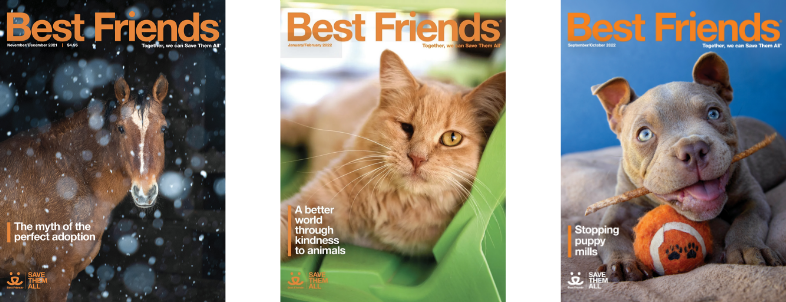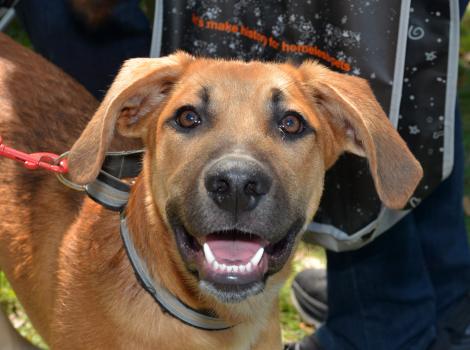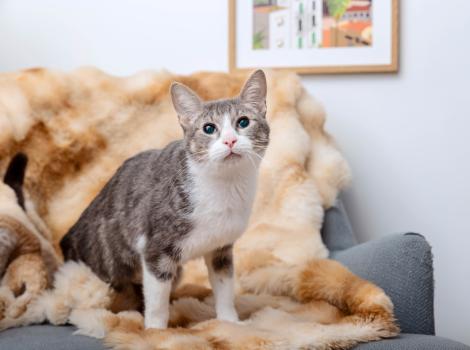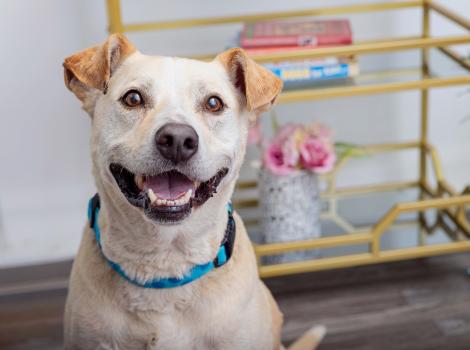The shape of our grief

I’m watching two dogs chase each other around a pile of lumber in my yard. One looks like a floppy-eared black fox, the other a lanky brown-and-white brindle character with a long, white-tipped tail. The two dogs maintain a distance of 9 to 10 feet between them at all times. They run one direction, with one dog in pursuit and the other being chased. Then they pause, alert, on opposite sides of the lumber — listening, smelling, but unable to see each other around the pile. One takes off in the opposite direction, prompting the second dog to start running as he sees his pursuer turn the corner.
This goes on for nearly 10 minutes. Both dogs wear wide-mouthed grins, tongues hanging. Their facial expressions convey, “I’m having such an awesome time! This stack of lumber is the best thing ever!” The animated whips of their tails as they stop and start spray pure joy, like magic wands, across the yard.
The two dogs are Charlie and Buster. My dogs. I lost them both to cancer four years apart, in 2017 and 2021. They were both 12 years old when they had to be euthanized. In both cases, I mistook subtle physical symptoms of their disease for arthritis and old age, and routine vet exams and blood work were not enough to catch the problem. The decisions to euthanize in both cases had to be made quickly and in one case traumatically.
When the pain of those losses creeps back into my consciousness, it is all-consuming. The grief and regret wash over me in unrelenting waves, and I find it hard to breathe. That’s when I grab my phone or computer and watch the video I took over a decade ago of Charlie and Buster blissfully chasing each other around that pile of lumber.

Feeling responsible for the loss of a pet
When we welcome pets into our lives and homes, we accept responsibility for their health, well-being, and longevity. We feed them, groom them, walk them, give them preventatives, and take them to the vet. We determine how much exercise they get, how many treats they eat, and wipe the mud (and anything else they might step in) off their paws. We decide when it’s time to pay for X-rays, blood work, and any new medications. If they get sprayed by a skunk, we’re the ones rinsing off their sad skunky eyes and saving them from their fabulously toxic stench.
So when one of our pets becomes terminally ill or passes away, it’s natural to feel like we failed at our most basic task. “We’re absolutely going to feel guilt, shame, and several other heart-wrenching emotions about ourselves if we believe that we should have been able to save our animal,” explains Dr. Katie Lawlor. As a clinical psychologist specializing in pet loss and grief, Dr. Lawlor helps people who have lost pets navigate their grief and find the resources they need to support their own mental health and process their loss. “As humans, our brains are hardwired to fix problems and find solutions,” she says. “But in the case of our pets passing or being diagnosed with a terminal illness, there is no solution and no answer.”
[Laced with grace: Saying goodbye to a beloved dog]
During the six months leading up to Charlie’s passing, he started showing little signs that something was off. The dog who would play fetch with a tennis ball for however long you were willing to throw it was now sitting down after one toss. The dog who always stole the good spot on the couch from the other pets was now napping alone in a cool corner of the basement. But otherwise, he seemed fine.
The oldest of our four dogs, Charlie was still eating and drinking, walking normally, and offering nothing noteworthy in vet exams or blood work. Then one week, things went downhill. The X-rays from our vet showed a possible mass next to his gallbladder and, two days later, he needed to be euthanized.
After that experience, I told myself that never again would I miss the signs that something was wrong with one of my pets. And then it happened again four years later with Buster. A mass ruptured next to an internal organ. We rushed him to the emergency vet at 3 a.m. and had to make the decision once again to relieve our dog’s pain by letting him go, immediately.
The events of that evening with Buster, along with every detail — big and small — haunt me still today. And wrapped around every bit of that memory is the dark, oppressive thought that I should have known and I should have prevented it.

Choosing compassion over cruelty toward ourselves
In an odd twist, blaming ourselves for however and whenever our pets pass comes to us as naturally as loving them does. “It’s easier for some of us to just really beat ourselves up than it is to accept a loss,” says Dr. Lawlor. “We, as humans, are really good at being pretty cruel to ourselves when we’re experiencing grief instead of being kind and compassionate.”
People with pets, people who work in fields like animal welfare and veterinary medicine, people who volunteer their time helping animals in their communities or assisting friends and neighbors with their pets are without question some of the most compassionate human beings around. Often, it’s their compassion that defines them. And yet somehow, that remarkable compassion retreats in those moments when they need it most for themselves.
To help explain this lack of self-compassion, Dr. Lawlor says there are two kinds of emotions that typically follow a traumatic loss. The first type is natural emotions (sadness, loneliness, longing, anger, etc.). “It’s essential for our mental health that we let ourselves experience all the emotions we have related to the loss so that they can run their natural course,” she notes.
She refers to the second type of emotions as “manufactured feelings.” “These feelings are not based directly on our natural response to the loss but rather on how we personally interpret the loss,” she emphasizes. “If we believe that we should have been able to save our pet … then we will absolutely feel guilty and ashamed.” Dr. Lawlor underscores that successfully modifying your interpretation of your loss will automatically change those manufactured feelings into “self-compassion for what you’ve gone through and the recognition that you gave your pet a wonderful life.”
Each time I watch that video of Charlie and Buster chasing each other around that pile of lumber so many years ago, having the absolute time of their lives, I am choosing compassion over cruelty for myself.

Finding comfort through our connectivity
For all the worries and woes we harbor these days about how problematic and pervasive technology has become in our lives, there’s no denying its power to provide us with multiple pathways through our grief and the resources we need to address it. From watching videos of animals to whom we’ve said goodbye and texting friends about those losses to accessing grief support groups and tools online, we have an endless supply of digital resources available to us when we experience the loss of a pet.
Best Friends has an Angels Rest Facebook group solely devoted to providing support and connection for people who have lost a beloved pet and are looking for a community where they can share and process that experience. “I always recommend checking with your local humane society or Best Friends for grief support options,” says Dr. Lawlor.
Pet Loss Community, founded by Dr. Lawlor along with veterinarians Dr. Lisa Lippman and Dr. Monica Tarantino, offers a range of online resources for people struggling with or preparing for the loss of a companion animal, including one-on-one help from a grief specialist and small online group support led by a specialist.
Connecting with others who have experienced the same type of grief, whether it’s in person or online, allows us to better understand and validate our feelings while also reminding us that we are not alone.

Preparing our hearts and minds for the next loss
Peaches, the oldest of our two current dogs, turned 14 this summer. She is the last of our original canine foursome, which included Charlie, Buster, and Hudson, who passed away when he was 14. While still healthy and fully capable of bounding across the yard to tell the squirrels exactly how she feels about them, Peaches is clearly showing signs of decline. Her once fawn-colored face is mostly white now. Her eyes are cloudy. Her breathing is heavier. Her spinal arthritis has turned her usual carefree trot into more of a careful hobble.
Most of us bring home our pets knowing full well that we will live longer than them and will have to endure their passing. In some cases, anticipation of that passing comes early with an unexpected event or terminal prognosis. In other cases, we simply realize that our pets are nearing the end of the normal life span for their species, and we must prepare ourselves somehow for the inevitable.
Anticipatory grief is a psychological term used to describe the grief experienced before an impending loss. “I actually think that anticipatory grief can be more difficult because we have it while they’re still here and … we put extraordinary pressure on ourselves to make their days perfect and be hypervigilant around their care,” explains Dr. Lawlor. “That’s really difficult to sustain.”
As I finish writing this, I’m sitting in my backyard watching Peaches lie on her side in the grass. I’ve probably taken a couple dozen photos and videos of her doing this. From a distance, the shape of her body and her fawn-colored fur make her look like a palomino pony who fell asleep in the pasture. She occasionally raises her head to sniff the air or tosses a playful paw in the direction of our younger dog when she wanders by. But mostly, she simply lies there peacefully, soaking up the sun and summertime smells. This is her favorite pastime. Watching her do this has become mine.
Like the video of Charlie and Buster bounding around the pile of lumber, these moments in the grass with Peaches are what I’ll turn to anytime the pain of her loss creeps back into the corners of my mind and dares me to choose self-blame over self-compassion.

This article was originally published in the November/December 2023 issue of Best Friends magazine. Want more good news? Become a member and get stories like this six times a year.
Let's make every shelter and every community no-kill by 2025
Our goal at Best Friends is to support all animal shelters in the U.S. in reaching no-kill by 2025. No-kill means saving every dog and cat in a shelter who can be saved, accounting for community safety and good quality of life for pets.
Shelter staff can’t do it alone. Saving animals in shelters is everyone’s responsibility, and it takes support and participation from the community. No-kill is possible when we work together thoughtfully, honestly, and collaboratively.







